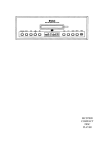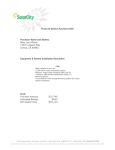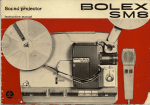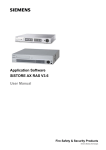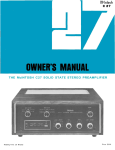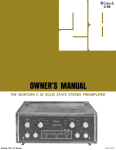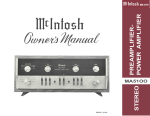Download THE MclNTOSH MA 5100 STEREO PREAMPLIFIER/POWER
Transcript
THE MclNTOSH MA 5100 STEREO PREAMPLIFIER/POWER AMPLIFIER
$1.25
Your MA 5100 stereo preamplifier/power
amplifier will give you many years of
pleasant and satisfactory performance.
If you have any questions concerning
the operation or maintenance of this
instrument, please contact:
CONTENTS
Guarantee
Installation
How to Connect
What the Controls Do
And How to Use Them
Balancing Your Stereo
Listening to Your Stereo
Performance Limits
Typical Performance Charts
Technical Description
Block Diagrams
CUSTOMER SERVICE
Mclntosh Laboratory Inc.
2 Chambers Street
Binghamton, New York 13903
Phone: 607-723-3512
Take Advantage of 3 years
of FREE Factory Service . . .
Fill in the Application NOW.
1
2, 3
3, 4, 5
5, 6, 7
7
8
8, 9
10
11
12
GUARANTEE
Mclntosh Laboratory Incorporated guarantees this
Instrument to be capable of performance as advertised. We also guarantee the mechanical and electrical workmanship and components to be free of
defects for a period of 90 days from date of purchase. If such defects occur, Mclntosh Laboratory
Or one of its authorized agencies will repair the
defect at no cost to the purchaser. This guarantee
does not extend to components damaged by improper use nor does it extend to transportation to
and from the factory or service agency.
THREE YEAR FACTORYSERVICE CONTRACT
An application for a FREE THREE YEAR FACTORY
SERVICE CONTRACT is included with this manual.
The terms of the contract are:
4. The SERVICE CONTRACT is issued to you as the
original purchaser. To protect you from misrepresentation this contract cannot be transferred to a
second owner.
1. Mclntosh will provide all parts, materials and
labor needed to return the measured performance
of the instrument to the original performance
limits free of any charge. The SERVICE CONTRACT does not cover any shipping costs to and
from the authorized service agency or the factory.
5. The SERVICE CONTRACT is given to purchasers
who live In the 50 United States or Canada only,
6. For your protection Mclntosh selects Its dealers
carefully. Only one dealer in ten qualifies for a
Mclntosh franchise. To receive the SERVICE
CONTRACT your purchase must be made from a
Mclntosh franchised dealer.
2. Any Mclntosh authorized service agency will repair all Mclntosh instruments at normal service
rates. To receive the free service under the terms
of the SERVICE CONTRACT, the SERVICE CONTRACT CERTIFICATE must accompany the instrument when taken to the service agency.
7. Your completely filled in application for a SERVICE CONTRACT must be postmarked within 30
days of the date of purchase of the instrument.
8. To receive the SERVICE CONTRACT all information on the application must be filled in. The
SERVICE CONTRACT will be issued when the
completely filled in application is received at
Mclntosh Laboratory Incorporated in Binghamton,
New York. If the application is not received at
Mclntosh Laboratory, only the service offered
under the 90-day guarantee will apply.
3. Always have service done by a Mclntosh authorized service agency. If the instrument is modified
or damaged, as a result of unauthorized repair the
SERVICE CONTRACT will be cancelled. Damage
by improper use or mishandling is not covered by
the SERVICE CONTRACT.
1
Copyright © 1972 By Mclntosh Laboratory Inc.
Position the plastic mounting template over the
area of the cabinet to be cut out for installation.
The design of the mounting template allows the
cutout to be positioned or located from the front
or rear of the panel to which the instrument is to be
mounted.
If the cutout is to be located from the rear of the
panel, the following steps will help you.
On the back of the cabinet panel, scribe a vertical
centerline through the exact center of the area in
which the cutout is to be made.
Place the template against the back of the panel
and match the template centerline with the centerline on the cabinet panel.
Make sure that there is at least ¼ inch clearance
between the bottom of the dashed line of the cutout
area on the template and any shelf or brace below
the proposed cutout.
Mark the two locating holes ("C" holes on the
mounting template).
Drill the two locating holes. Be certain the drill is
perpendicular to the panel.
Now position the template on the front of the panel
by aligning the "C" locating holes on the template
with the drill holes.
With template in place against the cabinet panel,
mark the "A" and "B" drill holes and the four small
holes that identify corners of the cutout. Join the
corner marks with a pencil. The edge of the template
can be used as a straight edge.
Adequate ventilation extends the trouble-free life
of electronic instruments. It is generally found that
each 10° centigrade (18° F) rise in temperature
reduces the life of electrical insulation by one half.
Adequate ventilation is an inexpensive and effective
means of preventing insulation breakdown that results from unnecessarily high operating temperatures. The direct benefit of adequate ventilation is
longer, trouble-free life.
IMPORTANT: DRILL THE 6 HOLES BEFORE MAKING THE CUTOUT.
Accurately drill the three holes on each side of
the cutout area with a 3/16 inch drill.
Allow at least 15 inches deep x 17½ inches wide
x 6 inches high for mounting the MA 5100. Always
allow for air flow by either ventilation holes or space
next to the bottom of the equipment and a means
for a warm air to escape at the top.
With the saw on the INSIDE OF THE PENCIL
LINES carefully cut out the rectangular opening.
It is recommended that it be mounted in a normal
or horizontal position. However, with adequate ventilation the instrument can be mounted in any position.
To prepare the MA 5100 for installation remove the
plastic protective covering. Turn the MA 5100 upside
down so that it rests on its top on the shipping pallet.
Remove the four plastic feet fastened to the bottom
of the chassis.
The professional mounting design eliminates the
need for any shelf or bracket to support the MA 5100.
It is completely supported by its own mounting
brackets.
2
How to connect
Secure the mounting strips to the rear of the
cabinet panel using two screws from the hardware
package.
Insert the screws in the center holes of the cabinet
pane! ("B" holes on the template) and tighten. The
screw head should pull into the wood slightly. (Use
the two % inch long screws for panels under ½
inch, or two 1¼ inch long screws for panels ½ inch
thick or larger.)
Attach the mounting brackets to the cabinet panel
using four screws.
CONNECTING A LOUDSPEAKER
The MA 5100 is designed for stereo operation only.
Do not connect the MA 5100 for monophonic operation. Damage to the loudspeaker may result.
Speakers are connected at the OUTPUT barrier
strips on the back panel of the MA 5100.
Connect the leads from the left loudspeaker to
the LEFT OUTPUT barrier strip. Connect the leads
from the right loudspeaker to the RIGHT OUTPUT
barrier strip. Use lamp cord, bell wire, or wire with
similar type of insulation to connect the speakers
to the amplifier. For the normally short distances of
under 50 feet between the amplifier and speaker, #18
wire should be used. For distances over 50 feet between the amplifier and speaker use wire of a larger
diameter (#16 or #14.)
Place the template over the mounting screws. The
mounting screws should be centered in the "A" and
"B" holes on the template. The sides of the mounting brackets should match the vertical dash lines
on the template. If necessary, loosen the screws and
push the brackets into alignment and retighten.
Insert the power cord through the opening. Carefully slide the MA 5100 into the opening so the rails
on the bottom of the equipment slide in the track of
the mounting brackets. Continue to slide the instrument in until the front panel is against the cabinet
panel.
CONNECTING TO THE AUXILIARY
Any high level program source such as another
tuner or a TV set can be connected to the Auxiliary
input jacks.
CONNECTING A TAPE RECORDER
Secure the instrument to the mounting brackets
by inserting the two knurled headed screws (from the
hardware package) into the back of the MA 5100
chassis, These screws pass through holes in the
back flanges of the mounting brackets.
To Record:
Connect a cable from the L TAPE OUTPUT to the
left high level input on the tape recorder.
Connect a cable from the R TAPE OUTPUT to the
right high level input of the tape recorder.
To
Playback/Monitor:
Connect the cable from the left channel output of
3
How to Connect
RECORDPLAYER
TAPE RECORDER
TUNER
LEFT LOUDSPEAKER
4
RIGHT LOUDSPEAKER
a tape recorder to the L TAPE MONitor input.
head on the tape deck (one without its own electronics) to the L TAPE HEAD input. Connect the
cable from the right tape recorder head to the R
TAPE HEAD input.
Connect the cable from the right channel output
of a tape recorder to the R TAPE MONitor input.
CONNECTING A STEREO TUNER
Connect the cable from the left channel tuner output to the L TUNER input.
GROUND CONNECTION
A single GROUND post is provided. Grounds for
turntables, record changers, tape decks, etc., should
be connected to this post. The left and right program
cables and the ground wire from that source should
be wound or twisted together. To avoid hum, make
sure the ground wire does not make any contact to
the shields of the left and right program cables between the program source and the MA 51000. The
only ground should be at the GROUND post on the
rear of the MA 5100.
Connect the cable from the right channel tuner
output to the R TUNER input.
CONNECTING A RECORD PLAYER TO PHONO 1
Connect the cable from the left channel of the
record player into the L PHONO 1 input.
Connect the cable from the right channel of the
record player into the R PHONO 1.
PHONO 2 is provided for the use of a second
record player.
AC POWER OUTLETS
There are 3 black AC power outlets and one red
outlet. The power to the black AC power outlets is
controlled by the front panel power switch. Use
these outlets for a tuner, tape recorder, etc. The
red receptacle is on at all times. Use the red outlet
for a turntable or record changer. The turntable or
record changer is protected by this arrangement.
It is necessary to turn off the turntable or record
changer with its own AC power switch.
Connect the cable from the left channel of the
record player into the L PHONO 2 input.
Connect the cable from the right channel of the
record player into the R PHONO 2 input.
CONNECTING A TAPE DECK FOR PLAYBACK
Connect the cable from the left tape recorder
What the Controls Do and How to Use Them
INPUT SELECTOR
AUX: Connects the output from any high level
program source requiring flat amplification to the
high level input stages. Such a source could be a
television set or other source that has output of
0.25 volts or more. In the AUX position the gain is
0 dB to the TAPE outputs. The input impedance
is 250,000 ohms.
level input stages. The response has been shaped
to compensate for the characteristics of the tape
head. The gain at 500 Hz is 44 dB to the TAPE outputs. The input impedance is 500,000 ohms.
BASS
The BASS is a concentric control. The outer knob
controls the low frequency response in the right
channel. The center knob controls the low frequency
response in the left channel. The two knobs are friction coupled. This permits them to be adjusted
together or independently. Clockwise rotation increases lows and counterclockwise decreases lows.
Turn control to the center position for flat response.
TAPE: Connects the output from a complete tape
recorder to the high level input stages. In the
TAPE position the gain to the TAPE OUTPUTS is
0 dB. The input impedance is 250,000 ohms.
TUNER: Connects the output from any AM, FM or
FM STEREO tuner to the high level input stages.
In the TUNER position the gain to the TAPE output is 0 dB. The input impedance is 250,000 ohms.
TREBLE
The TREBLE is a concentric control. The outer
knob controls the high frequency response in the
left channel. The center knob controls the high frequency response in the right channel. The two knobs
are friction coupled. This permits them to be adjusted together or independently. Clockwise rotation
increases highs and counterclockwise decreases
highs. Turn the control to the center position for flat
response.
PHONE 1: Connects the output of any magnetic
phono cartridge to the low level input stages. The
response has been shaped to compensate for the
characteristics of magnetic phono cartridges. The
gain at 1000 Hz is 42 dB to the TAPE outputs. The
input impedance is 47,000 ohms.
PHONE 2: Same as PHONO 1.
Tape Hd: Connects the output of any tape head
(a tape deck without its own electronics) to the low
VOLUME
The VOLUME control regulates the loudness in
both channels. The VOLUME control has been pre5
cision tracked throughout the listening range (0 to
—65 dB) for accurate stereo balance.
TAPE: The TAPE switch makes it possible to instantaneously compare recorded material with the signal
source. Tape jacks on the back panel are designed
to accept a signal from a tape recorder with a monitor head and preamplifier.
MODE SELECTOR: Connects the input program to
the loudspeaker in any of the following seven ways:
L to L & R: Connects the left input to both loudspeakers.
NORMAL . . . the program source is fed through
the power amplifiers and the loudspeakers.
R to L & R: Connects the right input to both loudspeakers.
MONITOR . . . the signal source becomes the recorded tape and is fed through the power preamplifiers and loudspeakers.
STEREO REV: Connects the left input to the right
loudspeaker and the right input to the left loudspeaker.
When the switch is in the MONITOR position a triangle is lighted above the switch. When the light is
on only the tape can be heard. To listen normally
the light must be off.
STEREO: Connects the left input to the left loudspeaker and the right input to the right loudspeaker.
PHASE: Electronically reverses phase in the left
channel to correct "out of phase" program sources.
MONO (L + R): adds the left input and the right
input and then connects the L + R program to
both loudspeakers.
SPEAKER: For private listening on headphones the
loudspeakers can be turned off. When the switch is
in the OFF position a triangle is lighted above the
switch. When the light is on sound will not be heard
from the speakers. Only the headphones will be
heard.
L + R to L: Connects the left plus right program
to the left loudspeaker only.
L + R to R: Connects the left plus right program
to the right loudspeaker only.
POWER: The POWER switch controls the AC input
power. It turns the MA 5100 on and off. The switch
also controls the three black AC outlets on the back
panel.
COMPensation
Use the COMP switch to correct for phono equalization introduced in the recording process. All current stereo recordings use RIAA equalization. Some
early stereo and mono recordings use LP equalization.
L. F. (LOW FREQUENCY FILTER): Use the L. F. filter
switch to reduce objectionable low-frequency noise
6
Balancing your Stereo
created by a turntable or record changer and acoustically coupled feedback.
FLAT
filter disconnected.
The performance and enjoyment of a stereo system is greatly increased when the sound is properly
balanced. The balance of the stereo system is affected by many things including room acoustics, furniture placement, room shape, small differences in
loudspeakers, etc. To assist you in balancing your
stereo system in your room here is the procedure
to determine correct phase and program loudness.
FILTER . . . low frequency rumble and noise below
50 Hz are reduced when the switch is in the FILTER
position.
H. F. (HIGH-FREQUENCY FILTER): Use the H. F.
filter switch to reduce objectionable high-frequency
noise such as record scratch.
TO ADJUST PHASE
FLAT . . . filter disconnected.
1. Play a familiar record.
FILTER . . . high frequency noises above 5000 Hz
are reduced when the switch is in the FILTER position.
2. Press the MODE pushbutton to the MONO position.
3. Turn BALANCE control to 12 o'clock position.
LOUDNESS
When the volume is reduced, the music will seem
to lose much of its bass and some of its treble.
This effect is due to the sensitivity characteristic
of human hearing. The response of the human ear to
bass tones decreases more rapidly than its response
to notes centered in the mid-tonal range. The LOUDNESS control automatically provides the correct
amount of bass required to compensate for this
change in response of the human ear at low-loudness
levels. In the COMPENSATED position the volume
control is converted to a loudness compensated control. Use this position to listen at low volume and
still hear full-bass response.
4. Stand about 10 feet in front of and midway between the loudspeakers. The sound should appear
to come from directly in front of you. If the sound
is not directly in front of you with the PHASE
switch in the NORMAL position, reverse the leads
on one loudspeaker. When the sound comes from
directly in front of you the speakers are in PHASE.
Use the PHASE switch to correct for out of phase
program sources.
TO BALANCE LOUDNESS
1. Press the MODE pushbutton to the MONO position.
2. Play a familiar record.
BALANCE
The BALANCE CONTROL adjusts for unequal volume in either the left or right channels. The volume
of each channel can be varied relative to each other
without affecting their combined loudness.
3. Turn the BALANCE control to the 12 o'clock position.
4. While the program is playing, stand between the
two loudspeakers. Listen for a difference in loudness between speakers. Next, set the MODE selector to STEREO. If there is then a difference in
loudness turn the BALANCE control toward the
speaker that is not as loud. Adjust the BALANCE
control until the sound is satisfactory between
both speakers.
LEFT . . . turning the control to the left accents
the left channel by reducing the right channel
output.
RIGHT . . . turning the control to the right accents
the right channel by reducing the left channel
output.
7
Listening to Your Stereo
Performance Limits
LISTENING TO A STEREO RECORD
Turn the INPUT SELECTOR to PHONO 1 and
PHONO 2, whichever is connected to the record
player you wish to hear.
Performance Limits are the maximum deviation
from perfection permitted for a Mclntosh instrument.
We promise you that your MA 5100 must be capable
of performance at or exceeding these limits or you
get your money back. Mclntosh is the only manufacturer that makes this guarantee.
Make certain the MODE SELECTOR is in the
STEREO or STEREO REVERSE position.
Adjust the VOLUME control to desired volume.
LISTENING TO A MONOPHONIC RECORD
Turn the INPUT SELECTOR to PHONO 1 or
PHONO 2, whichever is connected to the record
player you wish to hear.
Turn the MODE SELECTOR to MONO (L + R).
Adjust the VOLUME control to desired volume
LISTENING TO A STEREO TAPE RECORDER
Turn the INPUT SELECTOR to TAPE.
Set the MODE SELECTOR to STEREO or MONO,
depending on the program on the tape.
Adjust the VOLUME control to desired volume.
TO RECORD ON A STEREO TAPE RECORDER
All program sources are available at the TAPE
OUTPUT jacks. The program material is unaffected
by all front panel controls except the INPUT SELECTOR.
To monitor while recording, the tape recorder must
have separate record and playback or monitor heads.
The TAPE switch permits monitoring the tape recordings while in the process of recording. When
the TAPE switch is at at the MONITOR position it
will play the sound from the tape as it passes the
playback head, a moment after it is recorded. The
recording process continues as usual. When the
TAPE switch is at the NORMAL position the program
being recorded is heard.
LISTENING TO TAPE DECKS
To listen to tape from a tape deck, proceed as
follows:
Turn the INPUT SELECTOR to TAPE HD.
Turn the MODE SELECTOR to MONO (L + R) or
STEREO, depending on the program on the tape.
Adjust the VOLUME control to the desired volume.
LISTENING TO HEADPHONES
The HEADPHONE jacks have been designed to
feed low impedance dynamic headphones. Electrostatic headphones generally require higher power
than dynamic headphones. They must be connected
to the LEFT and RIGHT OUTPUT barrier strips on
the back of the MA 5100.
8
POWER OUTPUT
45 RMS watts continuous per channel into 4 or 8
ohms both channels operating 20 Hz to 20,000 Hz.
30 RMS watts continuous per channel into 16 ohms
both channels operating 20 Hz to 20,000 Hz.
HARMONIC DISTORTION
Does not exceed 0.25% at rated power output
from 20 Hz to 20,000 Hz with both channels operating. Typical performance is less than 0.1% at
rated power. Distortion decreases as output power
is reduced.
INTERMODULATION DISTORTION
Does not exceed 0.25% if instantaneous peak
power output is twice rated power or less per
channel with both channels operating for any
combination of frequencies 20 Hz to 20,000 Hz.
OUTPUT IMPEDANCE
4, 8, or 16 ohms
DAMPING FACTOR
50 with 4 ohms load, 100 with 8 ohms load, 200
with 16 ohms load
FREQUENCY RESPONSE
10 Hz to 20,000 Hz +0 —0.5 db at rated power
8 Hz to 50,000 Hz +0 —3.0 dB at rated power
INPUT IMPEDANCE
Auxiliary, TAPE, TUNER, and TAPE MONITOR:
250,000 ohms
PHONO 1 and PHONO 2: 47.000 ohms
TAPE HEAD: 500,000 ohms
INPUT SENSITIVITY
Auxiliary, TAPE, TUNER, and TAPE MONITOR:
0.3 volts
PHONO 1 and PHONO 2: 2 mV
TAPE HEAD: 2 mV
TOTAL NOISE
TOTAL NOISE (INCLUDING POWER AMPLIFIER)
Auxiliary, TAPE, TUNER, and TAPE MONITOR: 75
dB below rated output
PHONO 1, PHONO 2 and TAPE HEAD: 70 dB be-
low 10 mV input; equivalent to less than 3 microvolts at input.
TREBLE: The high frequency program material is
modified to suit your taste. Right channel is the outer
knob, the left channel is the inner knob.
TAPE OUTPUT
0.3 volts with rated input, less than 150 ohms
source impedance, to operate in 47,000 ohms or
greater.
VOLUME: Precision tracked at all listening levels.
(0 to —65 dB.) Does not change stereo balance as
loudness is changed.
VOLTAGE AMPLIFICATION IN DECIBELS
Auxiliary, TUNER, and TAPE to TAPE OUTPUT; 0
dB
MODE SELECTOR: Seven positions: Left channel
only to both speakers, Right channel only to both
speakers, Stereo Reverse, Stereo, Mono, L + R to
left speaker only, L + R to right speaker only.
PHONO 1 and PHONO 2 at 1000 Hz to TAPE OUTPUT: 42 dB
TAPE HEAD at 500 Hz to TAPE OUTPUT; 44 dB
COMPensation: Select from two circuits that tailor
the response to correct for the characteristics used
in the recording of phonograph records.
LEFT PLUS RIGHT OUTPUT
Adjustable 0 to 6 volts from generator impedance
of 5,000 ohms.
TAPE: Monitor the recorded program from the tape
or hear the program that is being recorded.
PHASE: Electronically reverse phase in the left channel to correct "out of phase" program sources.
BASS CONTROLS
±18 dB at 20 Hz, with friction clutch for independent adjustment of each channel.
SPEAKER: Switch the loudspeaker system ON or
OFF without affecting the performance of headphone
jacks.
TREBLE CONTROLS
±18 dB at 20,000 Hz with friction clutch for independent adjustment of each channel.
LF FILTER (Rumble Filter): Flat or roll-off 12 dB per
octave above 5,000 Hz, down 12 dB at 20,000 Hz.
HF FILTER
Flat, or 5,000 Hz cutoff, 12 dB per octave.
LOUDNESS: COMPENSATED position boosts low
frequencies for low level listening. Operates as a
function of volume control rotation so full compensation is obtained at lower volume levels and flat response is obtained at full volume.
LF FILTER
Flat, or 5,000 Hz cutoff 12 dB per octave.
SEMICONDUCTOR COMPLEMENT
23 Silicon Rectifiers and Diodes
34 Silicon Transistors
2 Silicon Bilateral Switches
2 TRIAC
BALANCE: Natural balance at center position, attenuation of left or right channel by rotating control.
POWER REQUIREMENTS
120 volts, 50 60 Hz, 70 watts at zero signal output,
200 watts at rated output
MECHANICAL INFORMATION
SIZE; Front panel, 16 inches wide by 5 7/16 inches
high; chassis, 15 inches wide by 4½ high by 14½
deep, including connectors. Clearance in front of
mounting panel including knobs, 1½ inches.
WEIGHT: 25 pounds net, 41 pounds in shipping carton.
FINISH: Front Panel: Anodized gold and black:
Chassis: Chrome and black.
FACILITIES AND FEATURES
INPUT SELECTOR: Select from six sources — A U X ilary, TAPE, TUNER, PHONO 1, PHONO 2, or TAPE
HD
BASS: The low frequency program material is modified to suit your taste. Right Channel is the outer
knob, the left channel is the inner knob.
9
Typical
Performance
Charts
20
RESPONSE IN DB
15
10
5
0
-5
-10
-15
-20
20
100
1000
FREQUENCY IN HERTZ
10000 20000
POWER VS. FREQUENCY
POWER OUTPUT
WATTS RMS
50
50
40
30
20
10
0
10
100
1000
FREQUENCY IN HERTZ
INTERMODULATION DISTORTION VS.
EQUIVALENT POWER OUTPUT
PERCENT INTERMODULATION
DISTORTION
PERCENT HARMONIC DISTORTION
HARMONIC DISTORTION VS. FREQUENCY
.6
.5
.4
.3
.2
.1
100K
10K
.6
.5
A
.3
.2
.1
0
0
1
10
POWER OUTPUT IN WATTS RMS
1
100
10
100
POWER OUTPUT EQUIVALENT WATTS RMS
10
Technical Description
followers. The first emitter follower is driven from the
output of the volume control. The second emitter
follower is direct coupled to the third stage. The third
stage is a high gain voltage amplifier.
PREAMPLIFIER SECTION
The phono and tape head preamplifier circuits in
the MA 5100 have three transistors in each channel.
The input selector switch connects the input jacks
to the first voltage gain stage of the preamplifier.
The input stage has high voltage gain and very low
noise. The next stage, an emitter follower, acts as
an impedance converter that matches the input stage
to the second voltage amplifier. The emitter follower
is direct coupled to the second voltage amplifier.
Signals pass through the input emitter follower
and then couple to the second and third tone control
stages through the tone control network. The tone
control contours are obtained by controlling the large
negative feedback around the second and third transistors. This negative feedback is used to accurately
shape the response. The large amount of negative
feedback also makes possible low distortion from the
tone control amplifier.
Negative feedback is used around the low level
section to reduce noise and distortion to an absolute
minimum. The negative feedback also provides precise frequency compensation for magnetic phono
cartridges and tape heads. The feedback remains in
effect through the entire audio bandwidth, even at
20 Hz where gain is the highest. This kind of careful
Mclntosh engineering assures you of lowest distortion performance.
The output of the tone shaping amplifier drives the
low frequency and high frequency filters and the
second section of the volume control. The filters are
designed to remove unwanted noises such as turntable rumble and record scratch. The filters remove
the maximum amount of objectionable material and
still have a minimum effect on the musical content
of the program material.
The output of the volume control is fed to a two
stage voltage amplifier that has very low noise
characteristics. Negative feedback is used to improve
the signal to noise ratio and assure an absolute
minimum of distortion.
The tape head input impedance is 500,000 ohms.
High tape head impedance permits uniform high
frequency performance from typical tape transport
playback heads.
The MA 5100 is ideal for tape recording. With an
input signal from a phono cartridge of 10 millivolts,
there is 1.4 volts available at the tape output jacks.
The phase switch is part of the left channel circuit.
The switch selects from two sources that are of equal
amplitude but are "out of phase" to each other. In
the normal position the phase is the same in both
channels. When the phase switch is in the 180° position the left channel is "out of phase" when compared to the right. Out of phase program source material is easily corrected with the use of this switch.
Phono input signal overload is virtually impossible.
At 1,000 Hz the phono input will accept greater than
125 millivolts without overloading. This is more than
than 4 times the output from most phono cartridges
when playing a low distortion phonograph record.
The phono input impedance is 47,000 ohms. This
matches the impedance of magnetic cartridges.
The preamplifier output is connected by the input
selector switch to the tape output, the tape monitor
switch, the balance control, the loudness compensation switch, and the first section of the volume control. This arrangement permits recording of the program without interruption and has the ability to monitor the recorded tape.
The use of a two section volume control performs
two important functions. First, the input section of
the volume control increases the signal handling
capability of the tone control amplifier. Use of this
arrangement makes overdriving the tone control amplifer almost impossible. Second, the output volume
control assures maximum signal to noise ratio regardless of the volume control position.
The tone control stages are made up of a three
stage amplifier. The first two transistors are emitter
11
Block Diagram
MclNTOSH LABORATORY INC.
2 CHAMBERS ST., BINGHAMTON, N. Y. 13903
607-723-3512
Design subject to change without notice.
Printed in U.S.A.
Be112002
038-605
















